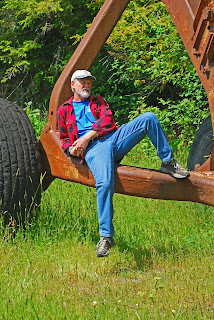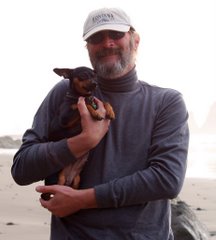The Klamath River—enmeshed in controversy—should bring people together. Its beauty and accessibility makes it perfect for a Sunday Drive.
 Not the Information Superhighway.
Not the Information Superhighway.
Indian Creek Viewpoint overlooking the Siskiyou Mountains and the Klamath River Canyon
Taken May 23rd, 2007
 The View from Indian Creek ViewpointSince the information signs (above) were somewhat less than informative,
The View from Indian Creek ViewpointSince the information signs (above) were somewhat less than informative,
you're welcome to make your own conclusions as to what you're seeing here.Taken May 23rd, 2007
Klamath River town names have long intrigued me. Of course there are the “normal” town names one often sees associated with any river, Klamath Falls, Oregon, Klamath River, California, and the Yurok Tribal Headquarters town of Klamath, near the river’s mouth. All of these are legitimate towns, having their own zip codes, and none of them feature in my journey down California Highway 96, which I call the Klamath River Highway.
I’ve long been intrigued by one town’s name in particular. Happy Camp, California, sits about midway between the Klamath River’s source and its mouth. Driving US Highway 199 between Crescent City, California and Grants Pass, Oregon, you see a sign pointing east toward “Waldo, Takilma, Happy Camp.” I’ve longed to drive this road finding my way to Happy Camp, so Wednesday morning, I set out to do just that. Filling the cooler at my local supermarket, the store manager asked where I was headed and I replied, “Happy Camp.” He was sure the road was still closed, having had to make a four and a half hour detour just last week. There was no longer snow on the highway, but there were trees down and he didn’t feel up to carrying his motorcycle across these natural barriers. With that happy thought in mind, I headed north on 199, stopping for a few geocaches in the Smith River Canyon, and filling the Saab’s gas tank in O’Brien, Oregon.
The station attendant informed me that traffic had been coming through from the Klamath River, so she didn’t foresee any problems with me driving in the opposite direction. Once past the back-to-the-land hippy community of Takilma, I found myself downshifting as the road climbed quickly and steadily from O’Brien’s elevation of 1412 to the state line at over 4700 feet. There is no “Welcome to California” sign as you cross the 42nd parallel, and only my GPS unit informed me that I was no longer in Oregon. Heading down toward the Klamath River and Happy Camp, I passed a sign warning of a nine percent downgrade for the next nine miles. I didn’t spend much more time in fifth gear going down the southern edge of Page Mountain than I had going up.
Driving along a tributary of the Klamath, Indian Creek, I stopped for a great photo op, catching a bridge, several sets of wires, lots of rock and rushing water. I also lost my footing and fell, dropping my Nikon D80 on the rocks. Fortunately, the sun shield protected the lens, and aside from some scrapes on both my body and the camera’s, we survived the experience.

Indian Creek, near Happy Camp, California
Terrified I would fall and drop my camera, I did!
Taken May 23rd, 2007
Happy Camp turned out to be a much larger community than I had imagined. The town limit signs indicated a population of eleven hundred living at an elevation of fourteen hundred feet. The Karuk tribe has an office complex here, but for the most part, the town seems to cater to the sportsmen who come to fish and raft the Klamath. That would be the case as I headed on through the River towns of Orleans, Weitchpec and Hoopa.
The Klamath River Canyon is steep and narrow, and in many places the highway glides hundreds of feet above the river itself. Unlike most canyon highways of my experience, the State of California has provided numerous places to pull off the highway and enjoy the view. Whether you are a photographer, a painter, or a poet, you have no excuse for ignoring your muse. And if you are a sportsman, you can pretty much pick your spot as there are river access points every few miles. The road itself is exactly the kind of road I love: smooth, curvaceous, and long. This is, in short, the ideal road for a Sunday Drive. The only problem is getting there in the first place.
It’s obvious to me that California did not build this highway to benefit the native inhabitants. I’ve never seen such a nice highway on tribal land. And make no mistake, this is tribal land. The Karuk have office complexes in Happy Camp, Orleans and Weitchpec. The Hoopa have their reservation on the Trinity River, south of where the Klamath turns west to the sea, and the Yurok, whose reservation straddles the Klamath from Weitchpec to the River’s mouth, patrol the highway in their Ford Explorers. To my mind, what proves my point is that the stretch of 96 south of Weitchpec, that is to say through the Hoopa lands, is narrow, twisty (as opposed to curvaceous) and has neither vista points nor river access. But I’m getting ahead of myself.
For a Sunday Drive, the drawback to California Highway 96 is its remote location. Just to get to Happy Camp from Smith River involved driving ninety-two miles of mostly two-lane mountain road. The thirty-eight miles from Takilma to Happy Camp took two hours (and I didn’t stop that many times for photo ops). Once at Happy Camp, I had a choice to make: turn around and return home the way I came; turn east and drive to Interstate 5, then north to Grants Pass and back south on 199; or head south on 96 and follow the Klamath River. Easy choice. I was out to see new country, and so what if it was 6 pm by the time I made it to Happy Camp. The mileage sign indicated that Willow Creek was approximately 100 miles south, an easy two hour drive, right? Then I’d head west on 299 to Arcata and catch 101 north and home. I didn’t remember quite how far Willow Creek was from Arcata, but in any event, it’s getting dark later and later, and no one is keeping tabs on me, so let’s go for it.
I should mention that I pulled out of my Smith River driveway a little after ten in the morning, and did stop at Ray’s Supermarket to stock up in case I found no restaurants or grocery stores along the way. By the time I hit 199 it was going on eleven, but I had stopped in an unsuccessful attempt to find a geocache at Ruby VanDeventer Park on the Smith. A couple (well six) geocache searches later, and it was four o’clock as I filled up the tank in O’Brien. I did find four of the six caches that I sought along 199. The Saab, I fear, is beginning to believe I think it’s a Jeep as we drove up some pretty poorly maintained forest roads. Thirteen hours after leaving home, I pulled back in the driveway, having given the car a proper run on great roads.
For over sixty miles, driving south of Happy Camp we followed the river, running at the posted speed limit, almost completely alone on the road. Somes Bar, the first “town” south of Happy Camp was barely a wide spot on the road, and it wasn’t until we crossed the lovely concrete suspension bridge into Orleans that we had to slow for civilization. Almost as much as Happy Camp, Orleans has fascinated me for years because it is the southern terminus of the Gasquet-Orleans Road. Oh you can’t drive from Gasquet to Orleans, at least not on the GO Road, as it’s called locally. There’s a great two lane road heading south from the Smith River. I assume the road heading north from Orleans is just as nice. Had it not been evening with many miles before me, I would have turned north on Eyesee Road just to see for myself. My understanding is that the road builders set out from the northern and southern ends simultaneously, building toward each other, but lawsuits stopped the project with just a seven mile gap to complete. There’s a geocache hidden at the southern end of the northern section with the title “The Road to Nowhere.”

Note that there's nothing "New" about Orleans
More people than feet, that's a start
Please note that the Saab is still getting around--that's it along the road
Taken May 23rd, 2007
As it was getting late, I took no pictures after leaving Orleans. That means I’ll have to go back, doesn’t it. Continuing on to Weitchpec, I considered turning west and taking the Bald Hills Road that I wrote about a few posts back. It’s the road that crosses the southern section of Redwood National Park, and where we found the fields of lupine. As I said, I thought about heading west, but continued south because I was so close to Hoopa, another town I’d long had on my wish list. Weitchpec itself has only recently come onto my radar, and there’s not a great deal there. The Karuk have a tribal complex, and there are a few churches, a general store, and a few other buildings, but all in all, you wouldn’t miss much if you missed Weitchpec. What is notable, especially in a Sunday Drive article, is that the Klamath River turns west here and California Highway 96 stops being such a nice road. The Trinity River, flowing north at this point, joins the Klamath for its final push to the sea.
Heading south from Weitchpec, I couldn’t help note that while I was still in a river canyon, I couldn’t see the river. Furthermore, the road was narrow and much more dangerous than what I’d been driving for the past hour or so. Apparently there’s nothing to attract the tourist/sportsman here—at least not in the opinion of CalTrans.
Hoopa was a surprise. I’ve heard of the town, the tribe, the reservation for most of my adult life. Since it is located off any of the roads I normally drive, I’d managed to avoid it for my first fifty-seven years. Since I didn’t turn west at Weitchpec, and the question here is how many times can I write Weitchpec in one blog, I came to Hoopa naturally. The town itself is comparatively speaking large, clean, and industrious. The high school alone rivals in size that of many communities several times the size of this reservation town. I need to go back earlier in the day so I can capture the scene in digital pixels. I must say, however, as a linguist, that whoever assigned the Roman alphabet to native American languages must have been practicing the linguistic equivalent of giving smallpox infected blankets to the Indians. Trying to pronounce the combinations of X,W, ?, etc that so many native languages seem to use is a sure way to put off any student wanting to study the language. That’s just my opinion, mind you.

Sign at Orleans, California
Not an example of what I'm talking about.
I'm sure it should be IX?Wi PIX?Wi instead.
And one of these days I need to drive the Ishi Pishi Road
Taken May 23rd, 2007
From Hoopa it’s a short, if twisty, drive on to Willow Creek and the end of the Klamath River Highway, California 96. Turning west at Willow Creek, I drove the 40 miles of California 299 to Arcata, taking roughly one hour to cover that distance. Dinner at Arcata consisted of Chicken Fried Steak, with a green salad, mashed potatoes, corn, and dessert of Coconut Cream Pie. The final hundred miles home on US 101 made me remember that my body doesn’t appreciate having so much carbohydrate at one time. Still, thirteen hours after leaving home, I pulled the Saab back into the garage, unloaded my books (if not the cooler), and went to bed.
The Klamath River highway is a great Sunday Drive, and I look forward to getting back over there, earlier in the day, or maybe even to spend a couple of days enjoying the scenic wonders of the Klamath and her canyon.
 I lied the other day. I do have roses blooming,
I lied the other day. I do have roses blooming,






















